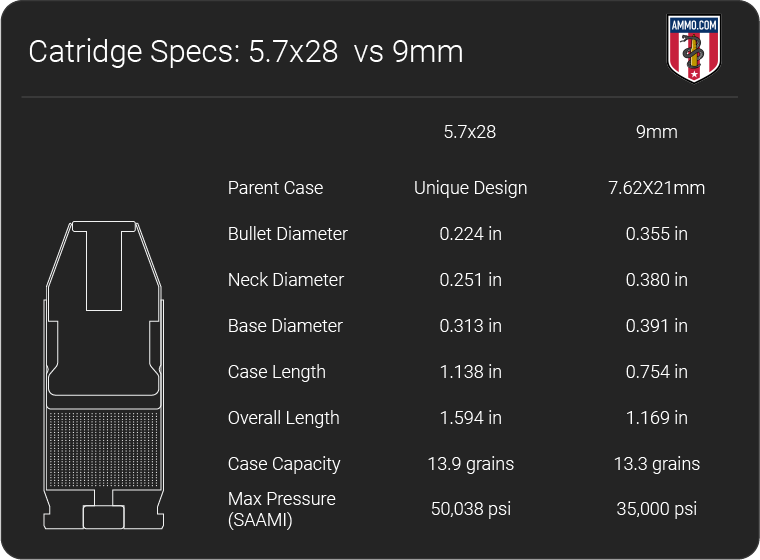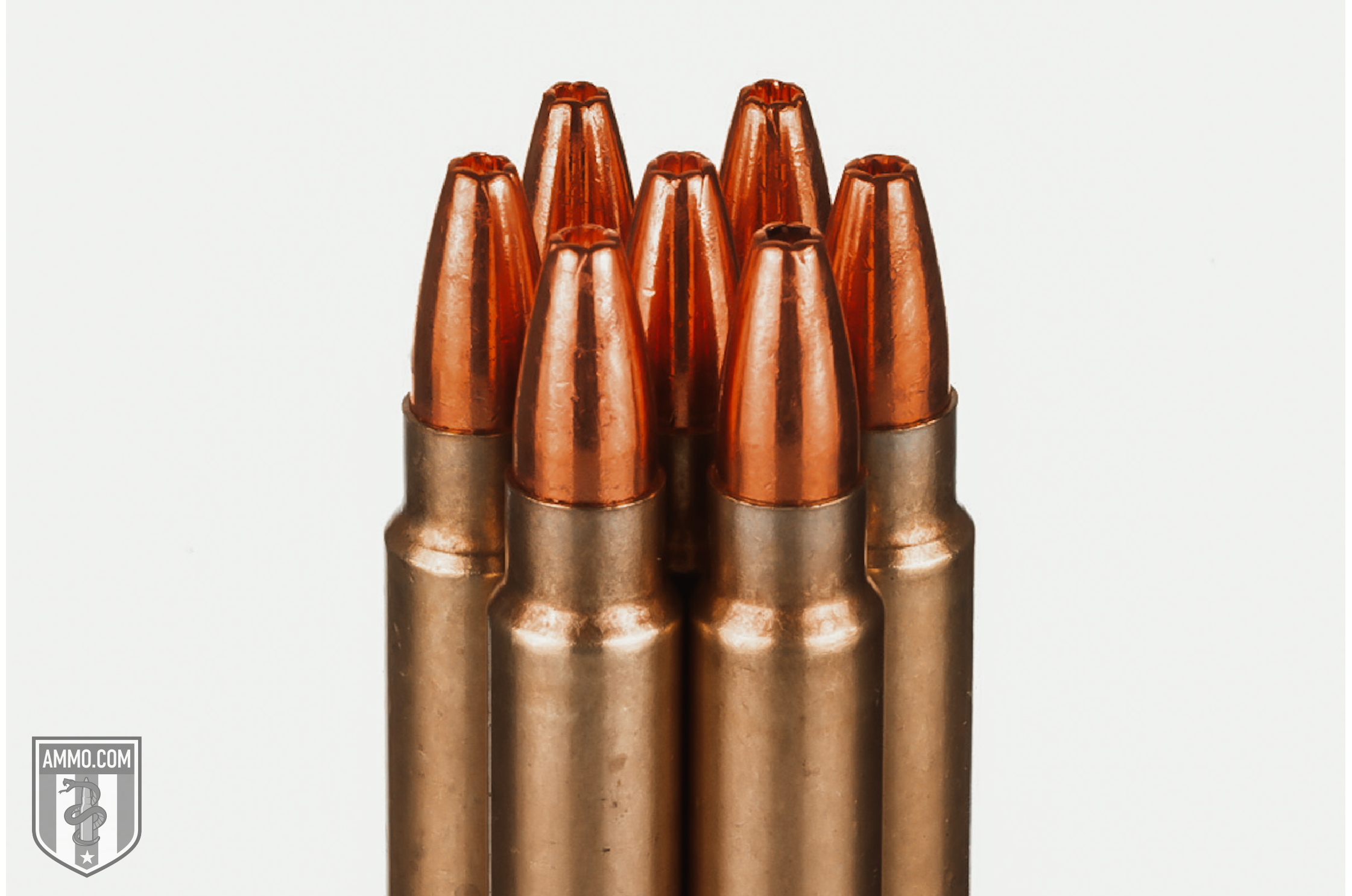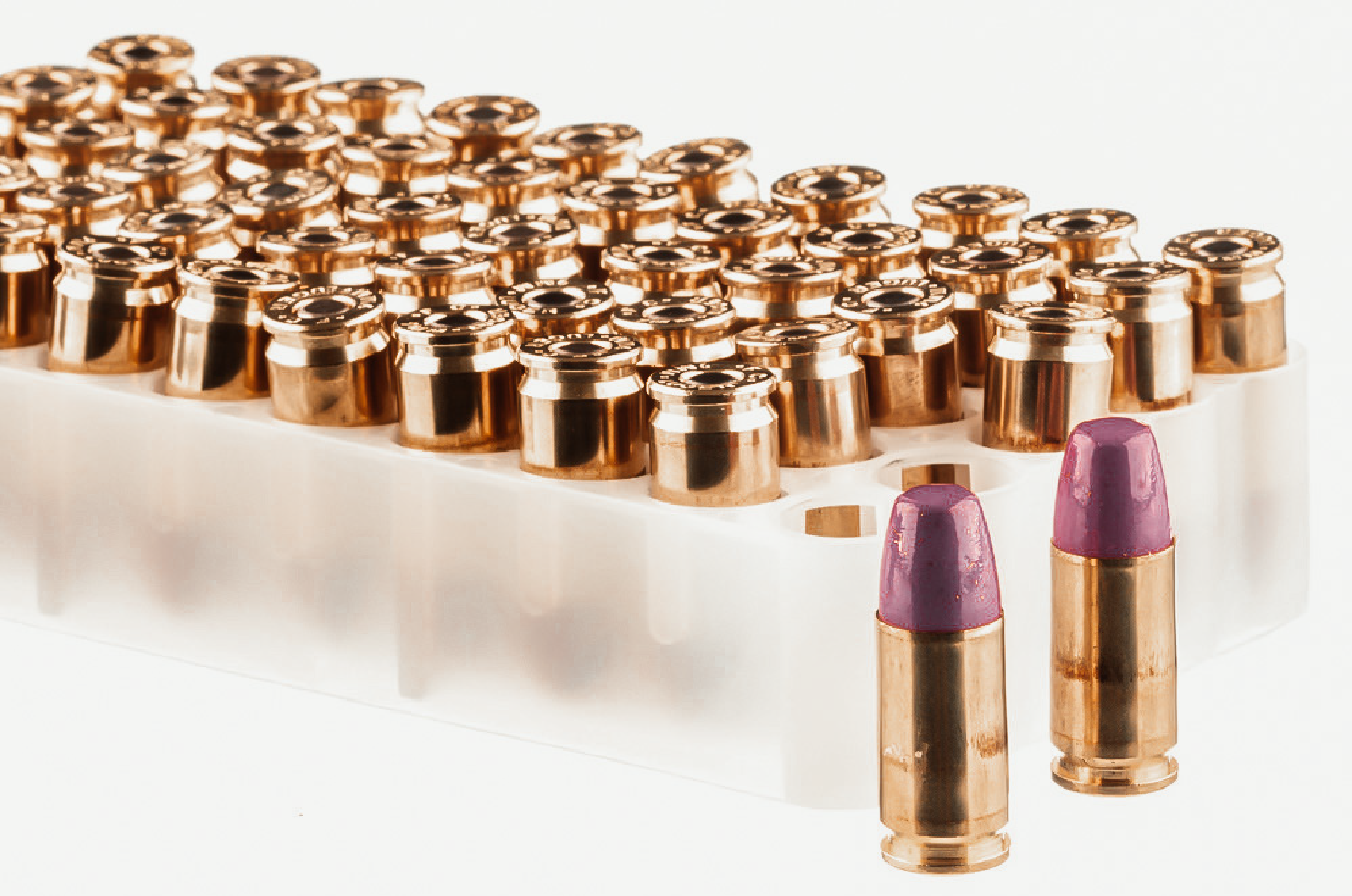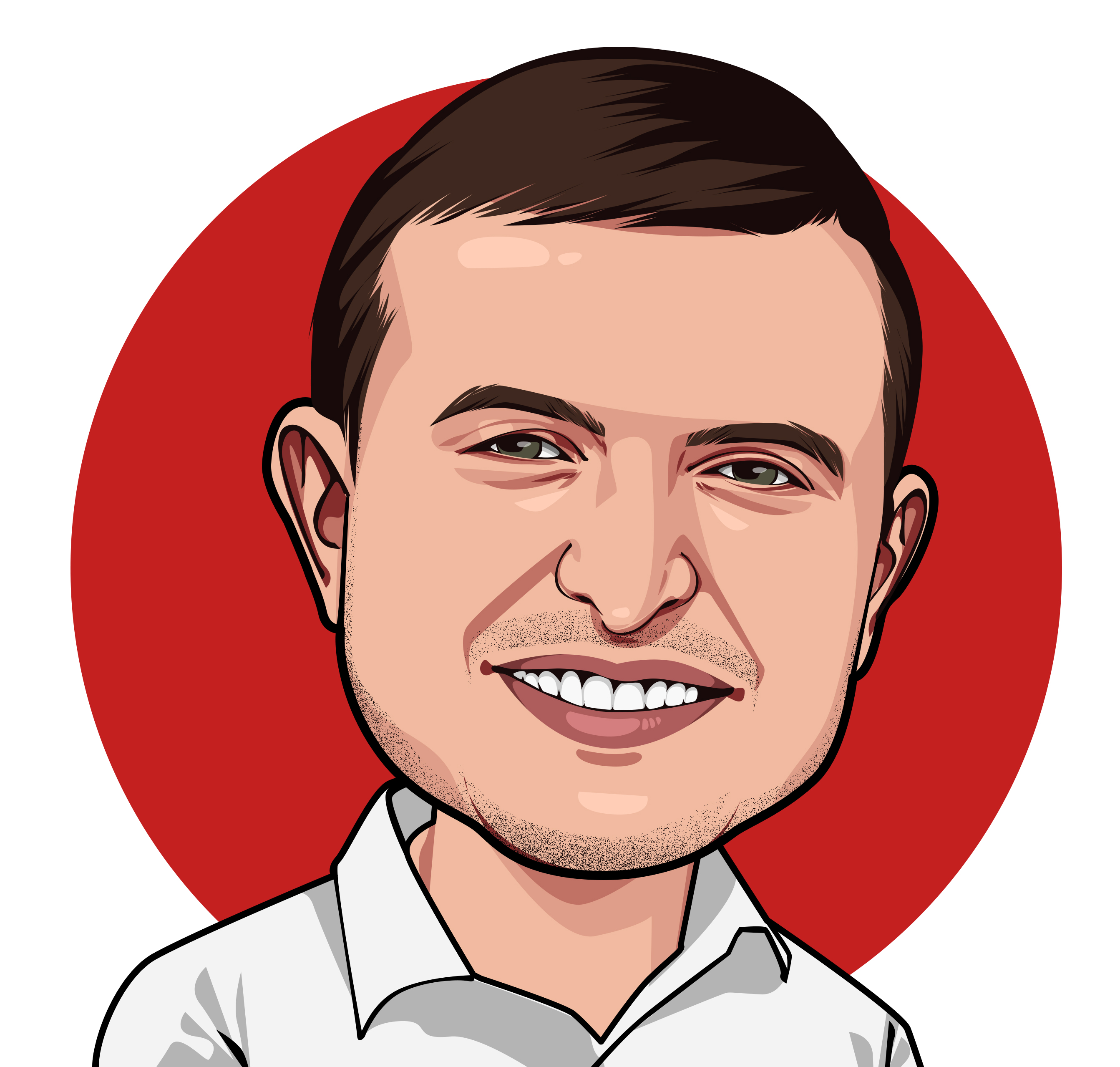5.7 vs 9mm: Has the 9mm Finally Been Replaced?
 When first comparing the 5.7mm vs. 9mm, one might think they're very different.
When first comparing the 5.7mm vs. 9mm, one might think they're very different.
The 9mm has a heavier bullet, while the 5.7 is more aerodynamic. The 9x19mm looks like a traditional semi-auto handgun round, and the 5.7 appears to be a miniature rifle cartridge.
The 9mm Luger was developed in the early 1900s, and the 5.7 wasn't designed until the late 1900s.
However, both were developed for the same purpose but can the newer 5.7x28mm outperform the time tested 9mm?
Let's find out who the winner is of the 5.7 vs 9mm!
5.7mm vs. 9mm: Differences and Similarities
The 5.7 was developed to replace the 9mm, which is a challenging task. So we should expect it to outperform the 9mm in nearly every aspect we test.
Don't count on the 9mm to go down without a fight. There's a reason it's been so popular for the last 100+ years. It has many dedicated fans that'll be difficult to convince to switch no matter the outcome of this article.
Cartridge Specs
The 5.7x28mm is the smaller cartridge in diameter, but it's longer than the 9x19mm Parabellum.
Most 9mm bullets are 115 grain or 124 grain. In comparison to the 5.7mm bullets at 40gr or 27gr.
On average, the 5.7 weighs half of the 9mm Luger. This makes for larger magazine capacities and easier to carry more rounds.
If you're looking for a small but powerful round like many law enforcement and government agencies, the 5.7 easily wins this matchup.

Recoil
Neither caliber is known as a heavy recoil round. That's often one significant advantage argued by 9mm enthusiasts in the 9mm vs. 45 debate because follow-up shots are more accurate when there is less recoil.
However, the 9mm NATO has been outdone in terms of recoil. This is expected since the 5.7 shoots smaller bullets.
This difference can be lessened by shooting a lighter 9mm bullet. Still, it's also not significant enough to be a significant factor because even when you shoot the lighter bullet, the 5.7 still has less felt recoil.
Shooting the rounds through a heavier gun will also lessen the recoil, but a heavy gun is tiresome to repeatedly shoot or carry all day.
I give the advantage to the 5.7mm because it has low recoil, even though the 9mm isn't known to have a lot of recoil.
Trajectory
Since both calibers were designed for handguns and submachine guns, their trajectories will not be as impressive as the 5.56 NATO or other calibers intended for long-range shooting.
Most shooters prefer a flat trajectory because it requires fewer calculations and adjustments.
At close range, the differences in trajectory are minimal. However, the faster bullet of the 5.7 ammo has a flatter trajectory as we increase the distance to the target than the bulkier 9mm rounds.
The 9mm was initially designed to be lethal out to 50 meters. While the 9 mil is lethal past 50 meters today, the trajectory of the bullet doesn't allow for it to be an effective long-range round, even in a carbine.
The 5.7 was developed to effectively pierce body armor at 200 meters. To accomplish this, it needs a flat trajectory so it can be accurate out to that distance.
The 5.7mm also wins this category.
Accuracy
Accuracy often depends on the skill level of the shooter. The gun, quaility of ammo, recoil, and bullet trajectory also factor into the accuracy of a fired round.
The more recoil a gun has, the less accurate the average shooter will be because they anticipate the recoil and jerk instead of squeezing the trigger.
The accuracy will be very similar at close ranges, where these rounds were designed to be used.
However, the 5.7x28mm will have an advantage over the 9mm ammo as the distance increases because of less recoil and the flatter trajectory.
Stopping Power
Stopping power is often an overrated and misunderstood metric for calibers.
The reason is that stopping power is determined by several factors, including penetration (which has several elements of its own) and velocity.
The better a bullet penetrates, the more stopping power it is considered to have. A higher velocity round will often have better penetration, but not always.
The tricky part comes into play when considering that a well-placed shot by any caliber can stop a threat.
So we will omit this scenario because it's unlikely to have a well-placed shot in an intense situation without a tremendous amount of training, and no, watching John Wick doesn't count.
One would think the heavier bullet weight of the 9mm Luger will give it an automatic win in this category, but that would be incorrect because FN designed the 5.7 caliber to replace the 9mm as a battlefield weapon.
Therefore, it needs to have excellent stopping power. In fact, one of the requirements for the 5.7 was that it required level IIIA body armor-piercing capabilities.
This is because soft body armor has been designed to stop 9mm bullets at close range.
For the average citizen, none of this matters because armor-piercing rounds are not available to the general public.
What does matter is that the 5.7 is a high-velocity bullet, but it also has less mass, which means it won't penetrate as well as a bullet with more mass.
In general, the 9mm bullet will penetrate better than the lighter 5.7mm bullet. This means it should have more stopping power even though the 5.7 travels at 1,800 feet per second (fps).
The 9mm finally has a win for the average shooter, but for the military and law enforcement, the 5.7 stands out because of its armor-piercing abilities.
Self-Defense
I don't expect to settle this debate in this short section because I know how long the discussion has been between the 9 vs. 40 vs. 45. I believe as the 5.7 continues to increase in popularity, it will also be considered for these debates as the best self-defense caliber.
In my opinion, the best self-defense caliber is the one you're most confident shooting.
So even though you carry a 500 Mag, which has incredible stopping power, if you're not accurate with it, the stopping power doesn't matter. Therefore, you won't be confident with the firearm if you're ever forced to use it.
The 9mm has proven itself an effective personal defense caliber through multiple wars and on the streets every day by law enforcement and civilians.
Since the 5.7mm was designed to replace the 9mm, it should be just as effective for self-defense. Many militaries and law enforcement agencies believe this to be the case since they're issuing this caliber to their people.
The 9mm continues to be my choice for concealed carry because of gun and ammo availability. More options in the 9mm caliber make it much easier to find a gun and ammo that fits you best.
For a home defense round, I still choose a 9mm because it's less likely to penetrate multiple walls than the 5.7 bullets. This means my family is safer from friendly fire.
The 9mm wins the personal defense weapon section, but this could change as the popularity of the 5.7 caliber increases and more guns and ammo options begin to hit the market.
Ammo Cost & Availability
Since the 9mm has existed for over 100 years, there are many ammo manufacturers.
You'll find 9x19mm ammo in your price range, with the cheapest FMJ ammo starting at around $0.30 per round. However, for self-defense ammo like a jacketed hollow point (JHP), you'll be paying closer to $1.60 per round.
One downside to the 9mm popularity is that 9mm is one of the first to be affected when an ammo shortage happens. It also means that it's one of the first to come back into stock. So availability might be delayed but not for long.
For more ammo options, keep in mind to browse our inventory of Remington 9mm ammo, PMC 9mm ammo and Fiocchi 9mm ammo.
Buying in bulk is always smart, make sure to check out our stock of 9mm bulk ammo.
The Federal brand, American Eagle 5.7x28mm ammo, is more expensive at $1.20 per round. However, a 5.7 JHP is $0.30 more affordable than a comparable 9mm, which is surprising because fewer manufacturers make 5.7 ammo.
This also means the 5.7 caliber is more challenging to find, even when other ammo is readily available.
The 9mm is the winner of this round because of the abundance of ammo at a lower price. This could change as the 5.7 continues to rise in popularity.
Gun Cost & Availability
Both calibers have been chambered in pistols and submachine guns, with pistols still being the most popular.
It's much easier to find a pistol chambered in 9mm than 5.7mm because only a select few manufacturers make a gun that fires 5.7 rounds. This also drives up the price of each 5.7mm firearm.
9x19mm firearms come in various price ranges, while 5.7x28mm firearms are priced on the higher end of the market.
An inexpensive Ruger 9mm pistol costs $339 compared to the $869 cost of the Ruger 57. The FN Five-seven pistol costs $1,319; you could buy a custom 9mm for this price. The Ruger PC Carbine chambered in 9mm is cheaper than the FN pistol.
However, the price is well deserved because FNH makes high-quality products.
The 9mm also wins this round because it's much easier to find a gun chambered in 9x19 at a reasonable price.
Reloading
Many serious shooters love handloading because it allows them to control all the controllable variables.
The nature of mass-produced ammunition means the ammo will not shoot as consistently as hand-loaded ammo because mass production ammo uses a range of specs instead of dialing in each round.
Put another way, when handloading, you make every round as close to the exact same as possible while mass production ammo passes inspection with close enough to the same.
Not all calibers and cartridges are designed to be reloaded. Take the .22lr, for example. It's a rimfire cartridge, so the brass can't be reused once it's been fired.
The 9mm and 5.7 are centerfire cartridges which means the brass can be reused.
9x19 reloading equipment and supplies are relatively easy to come by because it's a very common caliber.
With the 5.7, it's a different story. It is less common, but the case isn't designed well for reloading. The brass requires a dry lubricant to be easily extracted after firing.
This lubricant doesn't last after multiple firings, which adds cost and complexity to reloading the 5.7mm.
If you plan to dive into reloading, the well-established 9mm is the best option.
Ballistics
The team at Ammo.com crafted these incredible ballistics tables for each caliber. Use them to quickly reference and compare the 9mm vs. 5.7mm.
9mm Ballistics
Note: This information comes from the manufacturer and is for informational purposes only. The actual ballistics obtained with your firearm can vary considerably from the advertised ballistics. Also, ballistics can vary from lot to lot with the same brand and type load.
| 9mm Bullet WEIGHT | Muzzle VELOCITY (fps) | Muzzle ENERGY (ft. lbs.) | Mid-Range TRAJECTORY (in.) | Barrel Length (in.) | |||||
|---|---|---|---|---|---|---|---|---|---|
| Muzzle | 50 yds. | 100 yds. | Muzzle | 50 yds. | 100 yds. | 50 yds. | 100 yds. | ||
| 80 Grain | 1445 | n/a | n/a | n/a | 385 | n/a | n/a | n/a | n/a |
| 88 Grain | 1500 |
1190 | 1010 | 440 | 275 | 200 | 0.6 | 3.1 | 4" |
| 90 Grain | 1360 | 1112 | 978 | 370 | 247 | 191 | n/a | n/a | 4" |
| 92 Grain | 1325 | 1117 | 991 | 359 | 255 | 201 | -3.2 | n/a | 4" |
| 95 Grain | 1300 | 1140 | 1010 | 350 | 275 | 215 | 0.8 | 3.4 | 4" |
| 100 Grain | 1180 | 1080 | n/a | 305 | 255 | n/a | 0.9 | n/a | 4" |
| 105 Grain "Guard Dog" | 1230 | 1070 | 970 | 355 | 265 | 220 | n/a | n/a | 4" |
| 115 Grain | 1155 | 1045 | 970 | 340 | 280 | 240 | 0.9 | 3.9 | 4" |
| 123 Grain | 1110 | 1030 | 970 | 340 | 290 | 260 | 1 | 4 | 4" |
| 124 Grain | 1150 | 1040 | 965 | 364 | 298 | 256 | -4.5 | n/a | 4" |
| 125 Grain | 1110 | 1030 | 970 | 340 | 290 | 260 | 1 | 4 | 4" |
| 135 Grain | 1010 | 960 | 918 | 306 | 276 | 253 | n/a | n/a | 4" |
| 140 Grain | 935 | 890 | 850 | 270 | 245 | 225 | 1.3 | 5.5 | 4" |
| 147 Grain | 990 | 940 | 900 | 320 | 290 | 265 | 1.1 | 4.9 | 4" |
| 90 Grain +P | 1475 | n/a | n/a | 437 | n/a | n/a | n/a | n/a | 4" |
| 115 Grain +P | 1250 | 1113 | 1019 | 399 | 316 | 265 | 0.8 | 3.5 | 4" |
| 124 Grain +P | 1180 | 1089 | 1021 | 384 | 327 | 287 | 0.8 | 3.8 | 4" |
5.7 Development
NATO requested a replacement for the 9mm, so FN Herstal the 5.7x28 and released it in 1991. Kevlar body armor was becoming increasingly effective at stopping the 9x19mm, so NATO wanted a pistol cartridge capable of armor penetration.
The 5.7mm has proven to be the round NATO wanted. While it will take a while for it to replace the loved 9mm, many government and law enforcement agencies around the globe have adopted it for use.
5.7x28 velocities vary, with the SS190 firing a 30gr bullet at 2,350fps and the SB193 shooting a 55gr bullet at 1,000fps. The 5.7 muzzle energy ranges from 120 foot-pounds to 394 foot-pounds.
9mm Development
The 9mm dates back to the early 1900s when Georg Luger developed the 9mm Parabellum. By the beginning of WWI, the first submachine guns chambered in 9x19mm were introduced because of its ability to penetrate the average soldiers' gear.
The Browning Hi-Power came along in 1935 and caused the popularity of the 9mm during WWII to skyrocket. It was used by the armed forces, police agencies, and civilian self-defense. NATO adopted it as their official sidearm cartridge in 1955.
Since then, it's only risen in popularity, even with the addition of rounds like the 5.7x28.
Final Shot: 9mm vs. 5.7
To say the 9mm has been replaced is a drastic overstatement. The 9x19mm has been a staple for over 100 years and is here to stay.
However, if any caliber can replace the 9mm, it's the 5.7x28mm. It offers many of the same benefits the 9mm provided compared to the .45ACP. A higher-capacity magazine with lighter, more accurate bullets, and less recoil.
Even though the 5.7mm won a majority of the sections, I don't believe for one second that the 5.7 v 9mm debate is over. On the contrary, I think it's just begun.
Ammo Comparisons
- .308 vs 5.56
- 6.5 Creedmoor vs .308
- .300 Blackout vs .308
- .300 Win Mag vs .308
- .243 vs .308
- .308 vs .30-06
- 7mm-08 vs .308
- .270 vs .308
- 7.62x39 vs .308
- .223 vs .308
- .338 Lapua vs .308
- .380 ACP vs 9mm
- .223 vs 5.56
- .300 Blackout vs 5.56
- 9mm vs 45 ACP
- 9mm vs 40 S&W
- .357 SIG vs 9mm
- 10mm vs 9mm
- 9mm vs 9mm Luger
- .243 vs .270
- .300 Win Mag vs .30-06
- .270 vs .30-06
- .40 vs .45
- 38 Special vs 357
- 9mm vs 40 vs 45
- 5.56 vs 7.62x39
- 338 Lapua vs .30-06
- .30-30 vs .30-06
- 300 PRC vs 338 Lapua
- .30-06 vs 7mm
- 300 Win Mag vs 338 Lapua
- 300 PRC vs 300 Win Mag
- 300 WSM vs 300 Win Mag
- 338 Win Mag vs 338 Lapua
- 12 Gauge vs 20 Gauge
- 10mm vs 357 Mag
- .30-30 vs 7.62x39
- 224 Valkyrie vs 22-250
- 17 HMR vs 22 Mag
- 7.62x39 vs .300 Blackout
- 45 ACP vs 45 Auto
- 45-70 vs 30-30
- 300 Blackout vs 223
- 357 Magnum vs 9mm
- 350 Legend vs 300 Blackout
- 224 Valkyrie vs 223
- 45 ACP vs 38 Super
- 6.5 Grendel vs .308
- 17 HMR vs 22 LR
- 10 Gauge vs 12 Gauge
- 22-250 vs 223
- 45 Colt vs 45 ACP
- 350 Legend vs 30-30
- 5.7x28 vs 223
- 5.7 vs 9mm
- 5.56 vs 5.7
- 22 vs 9mm
- Buckshot vs Birdshot
- 450 Bushmaster vs 308
- 450 Bushmaster vs 223
- Buckshot vs Slug
- 6.5 Grendel vs 5.56 vs 223
- 6mm ARC vs 6.5 Grendel
- 44 vs 45
- 458 SOCOM vs 5.56
- 357 vs 44
- 32 ACP vs 380
- 300 Win Mag vs 338 Win Mag vs 338 Lapua Mag
- 450 Bushmaster vs 458 SOCOM vs 50 Beowulf
- 6mm Creedmoor vs 6.5 Creedmoor
- TMJ vs FMJ
- 44 Special Vs 44 Magnum
- 45 90 vs 45 70
- 6.8 Western vs 6.8 SPC
- 50 Beowulf vs 50 BMG
- 26 Nosler vs 6.5 PRC
- 28 Gauge vs 410
- 6.8 SPC vs 5.56
- 6.8 SPC vs 6.5 Grendel
- 6.8 Western vs 7mm Rem Mag vs .28 Nosler
- 6.8 Western vs 6.5 Creedmoor
- 22 Hornet vs 223
- 6.8 Western vs 6.5 PRC
- .410 vs 12 Gauge
- .410 vs 20 Gauge
- 22 LR vs 22 Mag
- 6mm ARC vs 243
- 7mm-08 vs 270
- 243 vs 6.5 Creedmoor
- Nickel vs Brass Casing
- 204 Ruger vs 223
- 50 Beowulf vs 5.56
- 260 Remington vs 6.5 Creedmoor
- 6mm Remington vs 243
- 28 Nosler vs 300 PRC
- 50 Beowulf vs 50 AE
- 22 Nosler vs 22-250
- 450 Marlin vs 45-70
- 300 Win Mag vs 300 Norma
- 458 SOCOM vs 300 Blackout
- 38-55 vs 45-70
- 22 Hornet vs 22 LR
- 300 Norma vs 338 Lapua
- 338 Lapua vs 50 BMG
- 28 Nosler vs 300 Win Mag
- 28 Nosler vs 6.5 Creedmoor
- 204 vs 22-250
- 458 SOCOM vs 45 70
- 44 40 vs 45 70
- 6.8 SPC vs 6.5 Creedmoor
- 450 Bushmaster vs 30-06
- 7mm Rem Mag vs 300 Win Mag
- 30 Carbine vs 223
- 25-06 vs 30-06
- 26 Nosler vs 28 Nosler
- 16ga vs 12ga
- 30 06 vs 7.62 x54R
- 9mm Makarov vs 9mm Luger
- 350 Legend vs 223
- 30 Carbine vs 5.56
- 6.5x55 vs 6.5 Creedmoor
- 6.5 Creedmoor vs 270 vs 25-06
- M193 vs M855
- 450 Bushmaster vs 458 SOCOM
- 6.5 Grendel vs 6.5 Creedmoor
- 350 Legend vs 5.56
- .277 Fury vs 6.8 SPC
- 277 Fury vs 300 Win Mag
- 10mm vs .45 ACP
- 277 Fury vs 223
- 6.8 SPC vs 300 Blackout
- 6.5 PRC vs 6.5 Creedmoor
- 277 Fury vs 308
- 277 Fury vs 6.5 Creedmoor
- 350 Legend vs 450 Bushmaster
- 277 Fury Vs 5.56 NATO
- 10mm vs 40S&W
- 32 ACP vs 9mm
- 32 Special vs 9mm
- 8.6 Blackout vs 300 Blackout
- 30 Super Carry vs. 9mm
- 5.56 vs 9mm
- .50 Action Express vs 9mm
- 7.62x25 vs. 9mm
- 10mm vs 44 Magnum
- 300 Blackout vs 300 Win Mag
- 6.5 Grendel vs 300 Blackout
- 460 Rowland vs 10mm
- 300 RUM vs 300 PRC
- 300 Norma vs 300 PRC
- 45 GAP vs 45 ACP
- 7mm PRC vs 300 Win Mag
- 300 PRC vs 6.5 Creedmoor
- 300 PRC vs 308
- 357 SIG vs 357 Mag
- 7.62x39 vs 7.62x51
- 243 Win vs 223 Rem
- 30 Nosler vs 300 PRC
- 6.5 Creedmoor vs. 30-06 Springfield
- 450 S&W vs. 44 Magnum
- 6.5 Creedmoor vs. 300 Win Mag
- 454 Cassull vs. 45-70 Govt
- 454 Cassull vs. 44 Mag
- 7.62x54r vs. 308 Winchester
- 22 ARC vs. 223 Rem
- Subsonic vs. Supersonic Ammo







